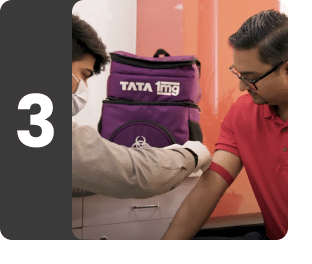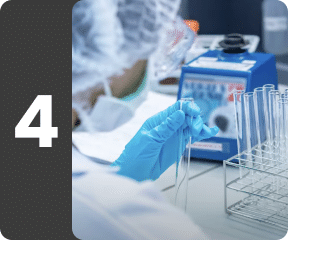Antenatal Profile near me in Gurgaon
Understanding Antenatal Profile in Gurgaon
What is Antenatal Profile in Gurgaon?
Pregnancy is an important phase in a woman’s life and the health of the child is directly related to the health of the mother. Antenatal Profile comprises of tests which screen for important infectious diseases like HIV and Hepatitis B in a pregnant female, which can be transmitted from mother to her child. It also includes tests such as CBC, TSH, Glucose- Fasting, Urine examination and more to ensure a healthy pregnancy.
Antenatal tests are important tools for protecting the health of a pregnant woman and her child. This panel of tests is performed in pregnant females to determine if the mother has any disease conditions that may interfere with normal development of the fetus and thus helping in identification of factors requiring special care.
What does Antenatal Profile measure?
Contains 40 tests
Complete Blood Count
Blood Stag is composed of blood cells suspended in blood plasma (yellowish-colored liquid). The blood cells include red blood cells (also called RBCs or erythrocytes), white blood cells (also called WBCs or leukocytes), and platelets (also called thrombocytes).
Red blood cells (RBCs) are the most abundant blood cells. RBCs contain hemoglobin which helps in the transportation of oxygen to the tissues. RBC count is the measurement of the number of RBCs in a given volume of blood.
Packed Cell Volume (PCV) or Hematocrit (Hct) is the measurement of the blood volume occupied by RBCs. It is expressed in percentage.
White blood cells (WBCs) are key components of the immune system and thus protect the body from various infections and cancers. Total Leucocyte count (TLC) is the measurement of the total number of leukocytes (WBCs) in a given volume of blood.
There are five types of WBCs:
-
Neutrophils
-
Basophils
-
Eosinophils
-
Lymphocytes
-
Monocytes
Differential Leucocyte Count (DLC) determines the percentage of different types of WBCs.
Neutrophils, Basophils, and Eosinophils are called Granulocytes because of the presence of granules inside these cells.
Absolute count of different types of WBCs is the measurement of their absolute numbers in the given volume of blood.
Platelet count - Platelets (also called thrombocytes) are disc-shaped cell fragments without a nucleus that help in blood clotting. Platelet count is the measurement of the number of platelets in a given volume of blood.
Mean Platelet Volume (MPV) is a measurement of the average size of platelets.
PDW or platelet distribution width refers to the variation of platelet size distribution
Hemoglobin (Hb) - Hemoglobin (Hb) is a protein found in red blood cells (RBCs) that carries oxygen from the lungs to the body tissues, exchanges the oxygen for carbon dioxide, and then carries the carbon dioxide back to the lungs where it is exchanged for oxygen.
Mean Corpuscular Volume (MCV) is the average volume of a red blood cell.
Mean Corpuscular Hemoglobin (MCH) is the average amount of hemoglobin in the average red blood cell.
Mean Corpuscular Hemoglobin Concentration (MCHC) is the average concentration of hemoglobin in a given volume of red cells.
Red Cell Distribution Width Coefficient of variation (RDW CV)is a measurement of the variability of the red blood distribution curve and their mean size.
Know more about Complete Blood Count
PDW
RDW CV
Absolute Lymphocyte Countx
Absolute Neutrophil Count
It gives us a measure of one of the components of the white blood cells , called Neutrophils. While all white blood cells help your body fight infections, neutrophils are important for fighting against bacterial infection.
Differential leucocyte Count
- Differential Neutrophil Count
- Differential Lymphocyte Count
- Differential Monocyte Count
- Differential Eosinophil Count
- Differential Basophil Count
Blood is made up of different types of cells which are suspended in a fluid called plasma. These include erythrocytes or red blood cells, leukocytes or white blood cells, and platelets. Blood cells are produced by the hematopoietic cells in bone marrow and are then released into circulation. RBCs carry oxygen to the tissues, platelets help in blood clotting at a site of injury, and leukocytes form an integral part of the immune system of the body.
WBCs are of five types, each having a different function and present in different numbers:
1. Neutrophils: Under normal conditions, the number of neutrophils present is higher than any other type of WBCs.. They provide protection against pathogens, mostly bacteria and sometimes fungi. Neutrophils engulf the pathogens completely and digest them (the process is called phagocytosis). They are usually associated with acute or short-term infections.
2. Eosinophils: Eosinophils are WBCs that are primarily responsible to fight parasitic infections. They are also involved in allergic reactions and regulation of the extent of immune response.
3. Basophils: Basophils are WBCs which are present in the lowest numbers in circulation. They are considered to play an important role in allergic response.
[Neutrophils, eosinophils, and basophils are together classified as granulocytes. Granulocytes are the WBCs which contain granules present in their cytoplasm. These granules secrete chemicals during immune response.]
4. Monocytes: Monocytes are WBCs which are also involved in protection against infectious pathogens by phagocytosis like neutrophils. However, monocytes are more commonly associated with chronic or long-term infections.
5. Lymphocytes: These are specialized WBCs which are responsible for recognizing and neutralizing foreign (non-self) cells and cancer cells in the body. Lymphocytes are of three types, all of which are differentiated from a common type of lymphocyte progenitor cell:
· T cells or T lymphocytes are produced in the bone marrow and mature in the thymus gland. They are responsible for differentiating between self and non-self cells of the body. T cells are also responsible for the initiation and extent of immune response, and targeted destruction of cancer cells and virus.
· B cells or B lymphocytes are control acquired immunity by producing antibodies against antigens found on foreign cells and pathogens like bacteria and viruses.
· Natural killer cells or NK cells destroy all foreign cells tagged by antibodies, cancer cells and virus-infected cells by phagocytosis.
Depending on various factors like age, gender, health condition, environmental factors, etc., varying amounts of different types of WBCs circulate in the blood. The bone marrow increases production of WBCs in response to an infection or inflammation anywhere in the body, which are then called to the site by a series of chemical signals, where they work to treat the condition. Depending on the condition, the count of one or more types of WBCs remains high in the blood. Once the condition subsides, WBC production by the bone marrow decreases and their count in circulation falls back to normal levels. Elevated amount of one or more types of leukocytes for a long time may be an indication of a chronic condition that is not resolving naturally and might need urgent attention.
Apart from an infection or inflammation, WBC count in blood can also be affected by other conditions like disorders of the immune system, autoimmune conditions, cancer, etc. One or more types of WBC count may be higher or lower than normal in these cases.
Differential Leukocyte Count Test serves as an indication of a condition affecting the body. Further tests are performed to confirm a particular condition and direct treatment.
This further contains
Red Blood Cell Count
Hemoglobin
The hemoglobin test measures the amount of hemoglobin in the blood.
Hemoglobin (Hb) is a protein found in red blood cells (RBCs) that carries oxygen from the lungs to the body tissues, and to exchange the oxygen for carbon dioxide. Hemoglobin then carries the carbon dioxide back to the lungs and where it is exchanged for oxygen. Iron is an essential part of hemoglobin. Most blood cells, including red blood cells, are produced regularly in your bone marrow (present within the cavities of many of large bones). To produce hemoglobin and red blood cells, your body needs iron, vitamin B12, folate and other nutrients from the foods you eat.
A decrease in hemoglobin concentration in blood results in anemia. Anemia is a blood disorder characterized by a decrease in the total amount of red blood cells (RBCs) or hemoglobin in the blood or a lowered ability of the blood to carry oxygen to body organs and tissues. Anemia is the most common blood disorder, affecting about a third of the global population and can cause symptoms like tiredness (fatigue), weakness, shortness of breath etc.
The hemoglobin test is usually performed as a part of complete blood count (CBC) test.
Platelet Count
The platelets will adhere to the injury site
The platelets will accumulate at the injury site
The platelets will release chemical compounds which stimulate gathering of other platelets
The platelet count measures the number of platelets present in the blood. Platelets are also known as thrombocytes which are tiny fragments of cells. These are formed from large cells which are found in the bone marrow known as megakaryocytes. After the platelets are formed, they are released into the blood circulation.
Whenever there is an injury to a tissue or blood vessel, bleeding starts. At this point, platelets help in stopping the bleeding in three ways:
With these steps, a loose platelet connection forms at the site of injury. This process is known as primary hemostasis. The activated platelets start to support the coagulation cascade which involves a series of steps that includes the sequential activation of clotting factors. This process is known as secondary hemostasis which results in the formation of fibrin strands that knit through the loose platelet connection to form a fibrin net. After that, the connection is compressed to form a stable clot so that it remains in place until the injury heals. Once the injury is healed, other factors come into play and break it down so that it gets removed.
In case the platelets are not sufficient in number or are not functioning properly, a stable clot might not form. These unstable clots can result in an increased risk of excessive bleeding.
Total Leucocyte Count
Blood is made up of different types of cells suspended in a fluid called plasma. These include erythrocytes or red blood cells, leukocytes or white blood cells, and platelets. Blood cells are produced by the hematopoietic cells in bone marrow and are then released into circulation. RBCs carry oxygen to the tissues, platelets help in blood clotting at a site of injury, and leukocytes form a part of the immune system of the body. WBCs are of five primary types: neutrophils, basophils, eosinophils, monocytes, and lymphocytes. Lymphocytes are further of three types: B-Lymphocytes, T-Lymphocytes, and natural killer (NK) cells. Neutrophils, basophils, eosinophils are collectively called granulocytes since they contain granules in cytoplasm.
Depending on various factors like age, gender, health condition, environmental factors, etc., varying amounts of different types of WBCs circulate in the blood. The bone marrow increases the production of WBCs in response to an infection or inflammation anywhere in the body. These WBCs are called to the site by a series of chemical signals, where they work to treat the condition. During this time, the total leukocyte count remains high in blood. Once the infection or inflammation subsides, WBC production by bone marrow decreases and WBC count in circulation falls back to normal levels. A continuously elevated WBC count may thus be an indication of a chronic condition that is not resolving naturally and might need urgent attention.
Apart from an infection or inflammation, WBC count in blood can also be affected by other conditions like disorders of the immune system, autoimmune conditions, cancer, etc. WBC count may be higher or lower than normal in these cases.
WBC count test serves as an indication of a condition affecting the body. Further tests are performed to confirm a particular condition and direct treatment.
Absolute Basophil Count
Absolute Monocyte Count
Absolute Eosinophil Count
The absolute eosinophil count measures the number of eosinophils present in the blood. Eosinophils, a type of white blood cells, helps in fighting the disease. These come into action for are said to be linked with certain infections and allergic diseases. The eosinophils are produced and mature in the bone marrow. They usually take about 8 days to mature and then are moved to blood vessels.
The eosinophils have varied functions which include the physiological role in organ formation such as the development of post-gestational mammary gland. Other functions include its movement to the areas of inflammation, trapping substances, killing cells, bactericidal and anti-parasitic activity. It also helps the treatment of immediate allergic reactions and modulation of inflammatory responses.
Hematocrit
Human blood is made up of erythrocytes or red blood cells, leukocytes or white blood cells, and platelets suspended in a fluid called plasma. Each of the component of blood performs a specific function. The packed cell volume or hematocrit is a ratio of the volume occupied by the RBCs to the total volume occupied by all the blood components or whole blood.
The RBCs transport inhaled oxygen from the lungs to all the cells of the body, and also a small amount of carbon dioxide from the cells to the lungs to be exhaled. The majority of carbon dioxide is transported in solution in plasma as bicarbonate ions. They contain a protein called hemoglobin which binds to oxygen for transport.
RBCs are produced in the erythropoietic cells of the bone marrow in response to the hormone Erythropoietin secreted by the kidneys when oxygen saturation of blood is detected to be low (hypoxia). The average lifespan of RBCs in circulation is 120 days. Hence, the bone marrows continuously produce RBCs to maintain a steady concentration in blood. The Packed Cell Volume Test depends on the count as well as the average size of the RBCs (Mean Corpuscular Volume or MCV). Higher than normal amount of RBCs produced by the bone marrow can cause the hematocrit to increase, leading to increased blood density and slow blood flow. Lower than normal hematocrit can be caused by low production of RBCs, reduced lifespan of RBC in circulation, or excessive bleeding, leading to reduced amount of oxygen reaching the cells.
Mean Corpuscular Volume
Mean Corpuscular Hemoglobin
Mean Corpuscular Hemoglobin Concentration
Mean Platelet Volume
GT New Test 2 added organ and changed name sample 45
utt

Glucose - Fasting
Glucose - Fasting Blood Test is done to measure the levels of glucose in blood during period of fasting.
Glucose is the main source of energy for body. Carbohydrates consumed in the diet are broken down in the body to glucose, which is absorbed by the intestines and transported by the blood to various organs. The cells of these organs utilize the glucose to produce energy when required, and the excess is stored either as glycogen in the liver for short-term storage or in fat tissues as triglycerides for long-term storage. The uptake, utilization, and storage of glucose after it is absorbed in the intestines is facilitated by the hormone- insulin which is secreted by the pancreas. Insulin influences the transport of glucose to the organs like heart, brain, working muscles, etc. It also directs storage of excess glucose. The action of insulin reduces sugar levels in the blood.
After a meal, sugar levels increase in blood and insulin is secreted in response to reduce sugar levels until it becomes normal. If glucose levels fall too low in blood, another pancreatic hormone called glucagon is released, which directs the liver to convert stored glycogen into glucose and releases it into the blood. The insulin and glucagon hormones create a feedback mechanism to keep blood glucose levels within the normal range. Imbalance in their activity causes an excess or shortage of blood sugar.
Glucose - Fasting blood Test helps to determine if the body is able to utilize or store glucose efficiently. High levels of sugar in blood indicates diabetes or resistance to insulin. Type 1 Diabetes is caused when insulin is not produced or produced in very little quantity. Type 2 Diabetes is caused when insulin produced is not utilized effectively by the body. In both these cases, blood sugar level rises, while cells are deprived of nutrition.
Know more about Glucose - Fasting

HIV 1 And 2 Antibody
Acquired Immunodeficiency Syndrome (AIDS) is caused by the Human Immunodeficiency Virus (HIV). HIV Virus is of two types: HIV-1 and HIV-2. HIV-1 is found in AIDS patients, AIDS-related complex patients, and those persons who are at high risk of getting affected by AIDS. HIV virus can be transmitted by sexual contact, exposure to blood or blood products of AIDS infected patients or transfer of infection from AIDS-infected mother to the fetus. Most of the cases of HIV-2 infected patients are seen in West Africa, and it is detected in patients who had sexual contact with people of that geographic region. These viruses have the same morphology, overall genomic structure, and ability to cause infection.
When the patient gets infected with the virus, the virus attacks the immune system called CD4 and combines with antibodies to use them for making a large number of copies inside the body of the patient by replication. During the first few weeks of infection, the amount of virus present and the level of p24 antigen in the blood becomes very high. After another 2-8 weeks, these increased levels start to fall as the body of the infected patient starts producing antibodies against the antigen of the virus. At this time, the HIV virus antibody can be detected in the patient’s blood via tests. The tests should be performed at this brief time because after some time both the levels of antigen and antibody in the blood falls. This will make the detection of virus infection difficult as the initial infection may have been resolved and you may not get a positive result against the infection.
The patients who fall under the risk for HIV-1 or HIV-2 infection are screened for HIV-1 or HIV-2 antigen or antibody screening test.
Know more about HIV 1 And 2 Antibody

Rapid Plasma Reagin
Syphilis is a sexually transmitted disease (STD), caused by the bacteria Treponema pallidum. It is most commonly spread by sexual route (through contact with syphilis sore (Chancre)). Syphilis is easily treatable with antibiotics. However, it can cause severe health problems if left untreated and can be potentially fatal. Maternal transfer to unborn child through an infected mother can cause serious and potentially fatal consequences for the baby.
There are several stages of syphilis:
· Primary syphilis: Primary stage starts 2-3 weeks after being infected. It usually appears as one or more painless chancres on the sexual partner's chancre exposed body parts such as on the penis or vagina. Since it is painless, it may go unnoticed, especially if it is in the rectum or on the cervix. It usually disappears within 4-6 weeks even without any treatment.
· Secondary syphilis: Primary syphilis can progress to secondary syphilis if the infected person is left untreated. The symptoms generally develop from 6 weeks to 6 months after the chancre first appears. It is mainly observed as non-itchy skin rash (rough, red, and spotted), appearing typically on the palms of the hands and the bottoms of the feet. Other associated symptoms could be fever, fatigue, swollen lymph nodes, sore throat, and body aches.
· Late or tertiary syphilis: Secondary syphilis can progress to late or tertiary stage if it is further left untreated. In this, an infected person may remain without any symptoms (asymptomatic) but continues to have the infection and can last for years. There are various complications associated with tertiary syphilis which can occur if still left untreated such as the bacteria can damage the heart, eyes, brain, central nervous system (Neurosyphilis), bones, joints, or almost any other part of the body. Tertiary syphilis can last for years, with the final stage leading to mental illness, blindness, other neurological problems, heart disease, and death.
Know more about Rapid Plasma Reagin

Thyroid Stimulating Hormone, Ultrasensitive
Thyroid Stimulating Hormone (TSH) test measures the amount of TSH in your blood which helps to find out if the thyroid gland is working normally or not. Low TSH levels indicate hyperthyroidism and high TSH levels indicate hypothyroidism.
In case of hyperthyroidism, the thyroid gland produces very high amounts of thyroid hormones (T3 and T4) and you may experience symptoms of weight loss, rapid heartbeat, tremors, sweating, anxiety, increased sensitivity towards heat, etc. In case of Hypothyroidism, there is a decrease in the production of thyroid hormones (T3 and T4) which may cause weight gain, fatigue, slow heart rate, increased sensitivity towards cold, depression, dry and thin hair, etc.
There is a feedback system in the body to maintain stable amounts of the thyroid hormones (T3 and T4) in the blood. TSH signals the thyroid gland to make and release the thyroid hormones (T3 & T4) into the blood when the level of thyroid hormones is low and can also signal the thyroid gland to lower the production of thyroid hormones when the level of thyroid hormones is very high. So, when the thyroid hormone (T3 and T4) levels decrease, the pituitary gland is stimulated to release TSH and this high TSH level, in turn, stimulates thyroid gland to release more thyroid hormone (T3 & T4) from the thyroid gland and the vice-versa happens when the thyroid hormone levels are very high.
Know more about Thyroid Stimulating Hormone, Ultrasensitive

Blood Grouping
The blood grouping test is done to identify blood group of a person. The blood group of a person is denoted on the basis of certain specific antigen markers present on the surface of the red blood cells. These marker antigens are glycoproteins and help the body to recognize its own type of RBCs. According to ABO and Rh blood group systems, three types of antigen markers are commonly found on RBCs, namely A, B, and Rh, and the presence or absence of these antigen markers determine the blood type of a person. Thus, a person with antigen A belongs to blood group A, one with antigen B belongs to blood group B, those with both antigens A and B belong to group AB, while those without either antigen A or B belong to group O. Also, people who have Rh antigen on their RBCs are Rh+ (positive), while those who do not are Rh- (negative).
Antibodies are naturally created by the body against incompatible blood antigens. People with blood group A have anti-B antibodies against type B antigens and those with blood group B have anti-A antibodies against type A antigens. People with blood group AB do not have any of these antibodies, while those with blood group O have both anti-A and anti-B antibodies. Rh antibodies are produced by people of Rh-blood group upon exposure to Rh antigens in Rh+ blood type. Blood transfusion between incompatible blood types causes an antigen-antibody reaction which causes the RBCs to clump together and be destroyed. Hence blood groups of donor and recipient must match to ensure the success of the blood transfusion or organ transplant.
The antigen-antibody reaction between incompatible blood types forms the basis of the Blood Typing Test. The collected specimen is treated with collected or synthetic A, B, and Rh antibodies and observed for agglutination (clumping). If agglutination (clumping) of RBCs is seen upon treatment with anti-A antibodies, the sample is of blood type A. If agglutination is seen upon treatment with anti-B antibodies, the sample is of blood type B. If agglutination does not occur upon treatment with either anti-A or anti-B antibodies, the sample is of blood group O, and if agglutination occurs with both these antibodies, the sample is of blood group AB. The occurrence of agglutination upon treatment with Rh antibodies indicates Rh+ blood type, while no agglutination indicates Rh- blood type.
ABO Typing:
Sample | Anti-A | Anti-B | Blood Type |
1 | Agglutination | No agglutination | A |
2 | No agglutination | Agglutination | B |
3 | Agglutination | Agglutination | AB |
4 | No agglutination | No agglutination | O |
Rh Typing:
Sample | Anti-Rh | Blood Type |
1 | Agglutination | Rh+ |
2 | No agglutination | Rh- |
Know more about Blood Grouping

Urine Routine & Microscopy
Urine Routine and Microscopy test involve the three-part evaluation of the urine sample.
1. Gross Examination - It involves the visual examination of the urine sample for color and appearance.
2. Chemical Examination - It is done by urine dip-stick method which involves the use of reagent test strips. These test strips are dipped into the urine sample and the colors that develop are matched with the control for analysis. It is done to examine the urine sample for glucose, protein, pH, specific gravity, blood, nitrites, ketones, leukocyte esterase, bilirubin, and urobilinogen.
3. Microscopic Examination - It involves the examination of the urine sample under the microscope for casts, crystals, cells, bacteria, and yeast.
Know more about Urine Routine & Microscopy
Glucose - Fasting Urine
The Glucose - fasting urine test measures the levels of glucose in urine during the period of fasting. The most common cause of high levels of glucose in the urine is diabetes. In diabetes, the way the body processes the glucose gets affected. The insulin hormone is responsible for controlling the metabolism of glucose in the blood. In diabetic patients, the body is either not able to make enough insulin or the body is not able to utilize the insulin produced. Due to this, the glucose starts to build up in the blood and the kidneys are not able to control it to release it into the urine.
The presence of glucose in the urine is termed as glycosuria or glucosuria. This could be due to side effects caused by certain medicines or problems in the kidney, such as renal glycosuria.
Urobilinogen
Ketone
Nitrite
Colour
Appearance
Specific Gravity
Epithelial Cell
Casts
Crystals
Protein Urine
The Protein, Urine measures the excessive protein excreted in the urine. The urine protein tests measure the protein which is released into the urine. Normally, the urine protein elimination is less than 150 mg/day and less than 30 mg of albumin/day. Temporarily raised levels may be seen in conditions such as stress, infections, pregnancy, cold exposure, diet, or heavy exercise.
The appearance of persistent protein discharge in the urine suggests possible kidney damage or the requirement of additional tests to know the cause.
In a normal functioning kidney, the filtered proteins are retained or reabsorbed and sent back to the blood. Whereas, if any damage is caused to the kidneys then it may affect their functioning which may cause detectable amounts of protein extracted into the urine.
Ph for Urine
Hepatitis B Surface Antigen, Serum
Book a Antenatal Profile test at home near me





Other tests









